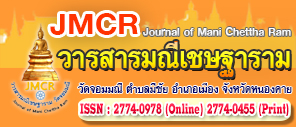THE SCHOOL ADMINISTRATION MODEL BASED ON GOOD GOVERNANCE IN THE DIGITAL ERA OF SCHOOL UNDER SECONDARY EDUCATION SERVICE AREA OFFICE
Keywords:
Measurement model, School administration, Good governance, Digital eraAbstract
The objectives were to (1) identify and validate the theoritical measurement model for school administration according to good governance in the digital era, (2) analyze the appropriate of the indicators of the model for school administration according to good governance in the digital era, and
(3) validate the structure of the model with the empirical data. The samples were 450 secondary school administrators under the jurisdiction of the Secondary Educational Service Area Office using the stratified random sampling. The sample size was set by using the online program, A-Priori Sample Size Calculator for Structural Equation Models. The instrument was questionnaire with 5-level rating scale. The questionnaire reliability score was 0.953.
It was found that the theoretical measurement model for school administration according to good governance in digital era had structural validation with the empirical data by the congruence indices; Chi-Square, Chi-Square/df, GFI, AGFI, CFI, RMSEA, and RMR. The obtained model consisted of 4 factors of school administration in digital era, 16 factors of school administration in digital era using digital technologies enhancing good governance, and 96 indicators for school administration in dital era using digital technologies enhancing good governance
References
กฎกระทรวงกำหนดหลักเกณฑ์และวิธีการกระจายอำนาจการบริหารและการจัดการศึกษา พ.ศ. 2550. ราชกิจจานุเบกษา. เล่ม 124 ตอนที่ 24 ก หน้า 29-36. (16 พฤษภาคม 2550).
กระทรวงเทคโนโลยีสารสนเทศและการสื่อสาร. (2559). แผนพัฒนาดิจิทัลเพื่อเศรษฐกิจและสังคม. เรียกใช้เมื่อ 10 มกราคม 2565 จาก https://www.mdes.go.th/content/download-detail/2798
ฐนัฐ วงศ์สายเชื้อ. (2560). แบบจำลองสมการโครงสร้างใน AMOS-#31 โมเดลการวัดแบบ Reflective vs. Formative Model. เรียกใช้เมื่อ 22 มีนาคม 2565 จากhttps://youtube/nIzMYm9aAg?si= LOUwvCSeAjxoD3Kw
ธนดล ทองประกอบ. (2562). ธรรมาภิบาลในยุคดิจิทัล: บทบาทของหน่วยงานกลางในการส่งเสริมการเป็นรัฐบาลแบบเปิดในประเทศไทย. วารสารการเมือง การบริหาร และกฎหมาย, 11(3), 107-126.
นวินดา ลาดกำแพง. (2565). การเพิ่มประสิทธิภาพการดำเนินงานโดยการใช้เทคโนโลยีสารสนเทศและดิจิทัล: กรณีศึกษา กองทุนเพื่อการบริหารจัดการการทำงานของคนต่างด้าว กรมการจัดหางาน กระทรวงแรงงาน. ใน การค้นคว้าอิสระหลักสูตรรัฐประศาสนศาสตรมหาบัณฑิต. บัณฑิตวิทยาลัย มหาวิทยาลัยรามคำแหง.
เปี่ยมพร ตังตระกูลไพศาล. (2560). กลยุทธ์การบริหารแบรนด์โรงเรียนเอกชนตามแนวคิดการลดภาระงบประมาณแผ่นดินด้านการศึกษา. ใน วิทยานิพนธ์ครุศาสตรดุษฎีบัณฑิต คณะครุศาสตร์ จุฬาลงกรณ์มหาวิทยาลัย.
ประกาศคณะกรรมการพัฒนารัฐบาลดิจิทัล เรื่อง แผนพัฒนารัฐบาลดิจิทัลของประเทศไทย พ.ศ. 2563-2565. ราชกิจจานุเบกษา. เล่ม 138 ตอนพิเศษ 127 ง หน้า 32. (14 มิถุนายน 2564).
ประกาศคณะกรรมการพัฒนารัฐบาลดิจิทัล เรื่อง แผนพัฒนารัฐบาลดิจิทัลของประเทศไทย พ.ศ. 2566-2570. ราชกิจจานุเบกษา. เล่ม 140 ตอนพิเศษ 84 ง หน้า 14. (10 เมษายน 2566).
พระมหาฉัตรชัย มูลสาร. (2562). ตัวบ่งชี้ภาวะผู้นำที่แท้จริงสำหรับครูโรงเรียนพระปริยัติธรรม แผนกสามัญศึกษา สำนักงานพระพุทธศาสนาแห่งชาติ. ใน วิทยานิพนธ์ศึกษาศาสตรดุษฎีบัณฑิต บัณฑิตวิทยาลัย มหาวิทยาลัยมหามกุฏราชวิทยาลัย.
รัฐธรรมนูญแห่งราชอาณาจักรไทย พุทธศักราช 2560. ราชกิจจานุเบกษา. เล่ม 134 ตอนที่ 40 ก หน้า 1-90. (6 เมษายน 2560).
ราชบัณฑิตยสถาน. (2556). พจนานุกรมฉบับราชบัณฑิตยสถาน พ.ศ. 2554. กรุงเทพมหานคร: นานมีบุคส์.
สำนักงานคณะกรรมการพัฒนาระบบราชการ. (2555). หลักธรรมาภิบาลของการบริหารกิจการบ้านเมืองที่ดี. เรียกใช้เมื่อ 20 มีนาคม 2565 จาก https://www2.opdc.go.th/content.php?menu id=5&content_id=2442
สุปรีดา โกษาแสง กฤษดา ผ่องพิทยา และสมชาย เทพแสง. (2565). เทคโนโลยีดิจิทัลสำหรับการบริหารสถานศึกษาในยุค Digital Transformation. วารสารบริหารการศึกษา มศว, 19(37), 242-250.
สุรศักดิ์ เก้าเอี้ยน (2564). การวิเคราะห์องค์ประกอบเชิงยืนยัน. เรียกใช้เมื่อ 21 มกราคม 2565 จาก https://www.youtube.com/watch?v=6Hyec8jP4Pg
เอกชัย กี่สุขพันธ์. (2559) . การบริหารสถานศึกษาในยุคดิจิทัล (School Management in digital Era). เรียกใช้เมื่อ25 มีนาคม 2565 จาก https://www.trueplookpanya.com./blog/content/52232/-edu-t2S1-t2t2s3-
เอกชัย กี่สุขพันธ์. (2561). การบริหารสถานศึกษายุคดิจิทัล. เรียกใช้เมื่อ 20 มีนาคม 2565 จาก http://www.Trueplookpanya.com/knowledge/content/52232-edu-teaartedu-teaart-eaartdir
Berryhill, J., Heang, K. K., Clogher, R. & Keegan McBride, K. (2019). Hello, World: Artificial Intelligence and Its Use in the Public Sector. Paris: OECD. https://doi.org/10.1787/726fd39d-en.
Christopher, J. M. (2019). From Theory to Practice: Open Government Data, Accountability, and Service Delivery. Policy Research Working Paper Series 8873, The World Bank. Retrieved on January 9, 2022 from https://ideas.repec.org/p/wbk/w brwps/8873.html
Council of Europe Portal 75: 1949-2014. (n.d.). Good Governance: Democracy and Technology. Formative Model. Retrieved on January 9, 2022 from https://www.coe.int/en/web/good-governance/democracy-and-technology.
International Social Security Association. (n.d.). Exelence in Administration ISSA Guidelines:Good Governance. Retrieved on January 9, 2022 from https://www.issa.int/guidline s/gg/174436
Schoemaker, E. (2004). A Shared Vision for Digital Technology and Governance: The role of governance in ensuring digital technologies contribute to development and mitigate risk. Retrieved on January 9, 2022 from https://www.undp.org/sites/g/files/zskgke326/files/2024-02/undpdsf-a-shared-vision-for-digital-tech nology-and-governance.pdf
United Nations Economic and Social Commission for Asia and the Pacific. (2009). What is Good Governance? Retrieved on January 9, 2022 https://www.unescap.org/resources/what-good-governance
UN. (2021). United Nations Conference on Trade And Development: Technology and Innovation Report 2021 Catching technological waves Innovation with equity. New York: UN Publications.


